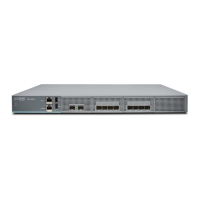How to Set Up Your SRX4100 Services Gateway
4
b. Verify that the DC power cables are correctly labeled before making
connections to the power supply. In a typical power distribution scheme
where the return is connected to chassis ground at the battery plant, you
can use a multimeter to verify the resistance of the -48V and RTN DC
cables to chassis ground:
• The cable with very high resistance (indicating an open circuit) to chassis
ground will be connected to the V- (input) DC power input terminal.
• The cable with very low resistance (indicating a closed circuit) to chassis
ground will be connected to the V+ (return) DC power input terminal.
c. Remove the clear plastic cover from the terminal studs on the faceplate.
d. Remove the screws on the terminals by using a Phillips (+) screwdriver,
number 2.
e. Secure each positive (+) DC source power cable lug to a RTN (return)
terminal. Secure each negative (–) DC source power cable lug to a -48V
(input) terminal.
f. Tighten the screws on the power supply terminals until snug using the
screwdriver. Do not overtighten.
1
g. Replace the clear plastic cover over the terminal studs on the faceplate.
h. Remove the tape from the switch handle of the circuit breaker on the panel
board that services the DC circuit, and switch the circuit breaker to the ON
(|) position.
i. Verify that the IN and OUT LEDs on the power supply are lit green and are
on steadily.
3. Wait until the Status LED on the front panel of the services gateway is solid
green before proceeding to the next step.
atus
SSD
Connect to the Console Port
1. Attach an electrostatic discharge (ESD) grounding strap to your bare wrist,
and connect the strap to the ESD point on the chassis.
2. Plug the RJ-45 end of the DB9-to-RJ-45 cable into the Console port on your
services gateway.
2
DB9-to-RJ-45 cable
Console port
Serial port
3. Connect the other end of the cable to the serial port on the management
device. Use the following values to configure the serial port:
Baud rate—9600; Parity—N; Data bits—8; Stop bits—1; Flow control—None.

